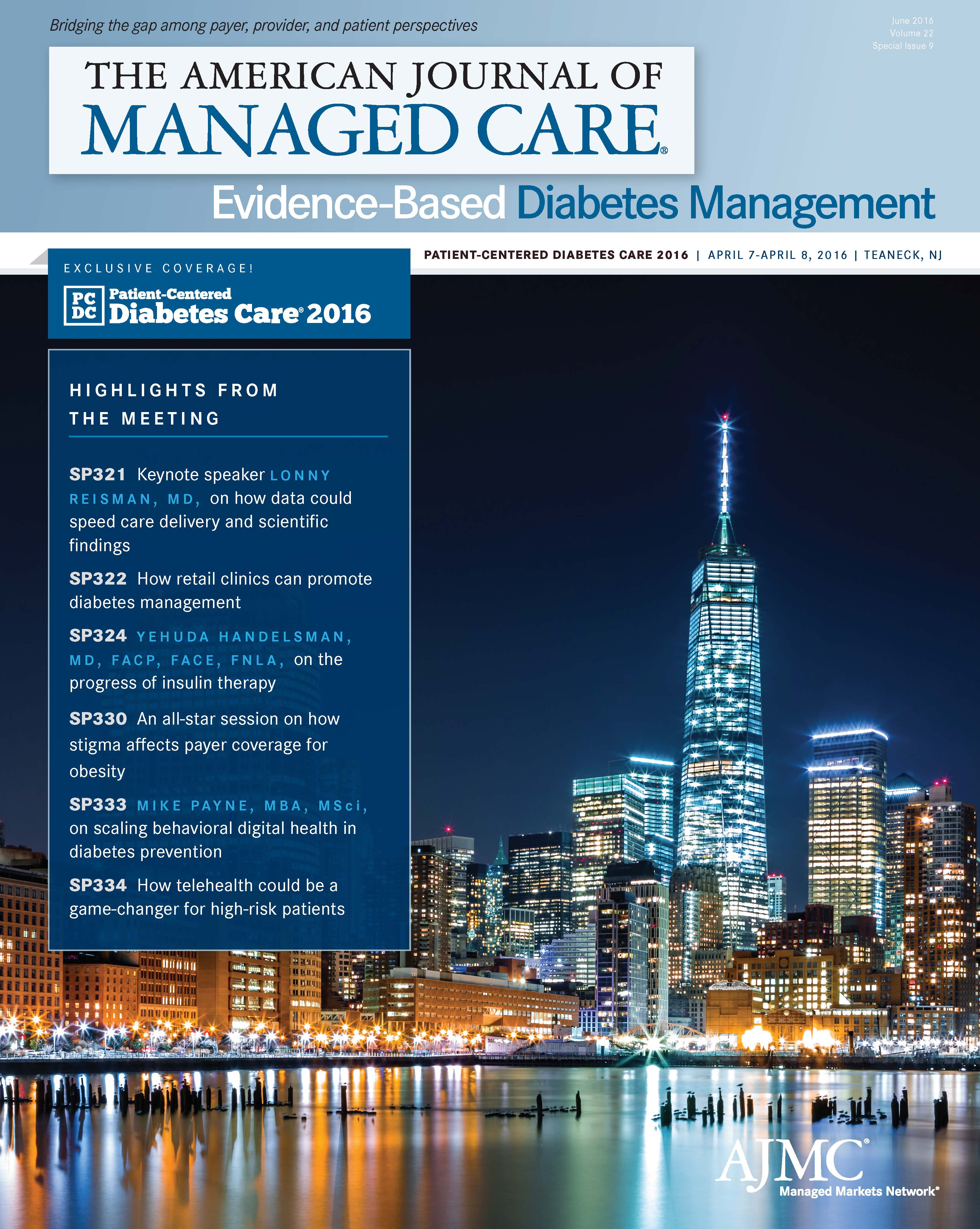- Center on Health Equity & Access
- Clinical
- Health Care Cost
- Health Care Delivery
- Insurance
- Policy
- Technology
- Value-Based Care
Coverage for Obesity Improving, but More Progress Needed, Kyle Says
Coverage from Patient-Centered Diabetes Care, April 7-8, 2016. Presented by The American Journal of Managed Care and Joslin Diabetes Center.
Payer coverage for obesity therapy and surgical treatment has improved recently, but more must be done—especially given the burden the disease presents, a leading advocate told attendees at Patient-Centered Diabetes Care (PCDC).
Ted Kyle, RPh, MBA, founder of ConscienHealth and chair of the Obesity Action Coalition, addressed attendees April 8, 2016, on the second day of the meeting presented by The American Journal of Managed Care and Joslin Diabetes Center. Too often, he said, healthcare discussions of obesity treat the disease as an abstraction instead of realizing that real people are living with this condition.
“Whether or not the healthcare plans cover care for obesity, we are paying for obesity,” Kyle said. “Our sick care system does a great job of treating the result.”
Untreated obesity harms nearly every organ system, he said, causing breathing problems, osteoarthritis, gout, cataracts, and liver and gallbladder issues. Obesity contributes to 2 of the costliest health conditions in the United States: diabetes costs $245 billion annually and heart disease costs $444 billion.1,2
The 2013 declaration by the American Medical Association that obesity is a disease was an important step—given that years ago, it would have been considered fraud to bill for obesity. However, reimbursement for therapeutics and other components of care has taken time to evolve, Kyle said. Another key step came when the US Preventive Services Task Force called for plans to cover obesity screening and evidence-based behavioral health counseling, he said. But, “working that out on the ground has been rather tedious.”
Today, he said, formularies with 74 million covered lives now pay for obesity medication, and Saxenda— the version of liraglutide indicated for obesity— was included in the CVS Health formulary in 2016. Overall, however, uptake has been slow. In the weeks after PCDC, the Pink Sheet reported the difficulties that pharmaceutical companies have had selling FDA-approved therapies, despite the fact that more than one-third of US adults (34.9%) were obese as of 2012.3,4
Kyle shared employer data that show that although most large employer plans cover bariatric surgery and have for years, less than 50% of the plans that cover fewer than 500 employees will cover it. Of the employer-based wellness programs that are based on body mass index (BMI), 90% will pay for patients to see a doctor, but only 60% will pay for a dietitian, which is slightly more than half.
“There have long been coverage exclusions for obesity,” Kyle said. He described going through chart reviews with some health plans and seeing the alarming number of cases where obesity medication might have been indicated, but being told,that plans would simply continue to pay for the results of comorbidities—like diabetes and strokes.
The ongoing problem of bias—the belief that persons with obesity “did it to themselves”—prevents care from being as comprehensive as it could be, he said. Kyle reported that nearly three-quarters (74%) of physicians don’t screen for BMI, and the session also reported that 70% of doctors won’t give referrals for surgery. Despite this, he said, there’s good news: several recent studies have shown that bariatric surgery not only treats obesity, but the procedure can also reverse type 2 diabetes in some patients, making it more cost-effective.5,6
And, finally, CMS is moving forward with paying for prevention. Like several speakers, Kyle noted the giant step taken in late March when HHS Secretary Sylvia Mathew Burwell announced Medicare will soon pay for the National Diabetes Prevention Program. This evidence-based lifestyle initiative was shown to save Medicare $2650 per patient after 15 months for those who completed the program.7
“Bad coverage habits are dying hard,” Kyle said. “But they are dying.” 1. American Diabetes Association. Economic costs of diabetes in the U.S. in 2012. Diabetes Care. 2013;36(4):1033-1046. doi: 10.2337/dc12-2625.
2. National Center for Chronic Disease and Health Promotion. Heart disease and stroke prevention: addressing the nation’s leading killers. CDC website. cdc.gov/nccdphp/publications/AAG/pdf/dhdsp.pdf.
3. Caffrey M. Report on retreat of obesity drug marketing shows lack of parity in coverage. The American Journal of Managed Care website. ajmc.com/ newsroom/report-on-retreat-of-obesity-drug-marketing-shows-lack-of-parityin- coverage. Published May 16, 2016. Accessed May 23, 2016.
4. Obesity rates and trends. The State of Obesity website. http://stateofobesity. org/rates/. Updated September 2015. Accessed May 23, 2016.
5. Schauer PR, Bhatt D, Kirwan J, et al. Bariatric surgery vs. intensive medical therapy for long-term glycemic control and complications of diabetes: final 5-year STAMPEDE trial results. Presented at: the 65th Scientific Session of the American College of Cardiology; April 4, 2016; Chicago, IL. Abstract 416-12.
6. Cummings DE, Arterburn DE, Westbrook EO, et al. Gastric bypass surgery vs intensive lifestyle and medical intervention for type 2 diabetes: the CROSSROADS randomized controlled trial. Diabetologia. 2016;59(5):945- 953. doi:10.1007/s00125-016-3903-x.
7. Independent experts confirm diabetes prevention model supported by Affordable Care Act saves money [press release]. Washington, DC: HHS; March 23, 2016. hhs.gov/about/news/2016/03/23/independent-experts-confirm- diabetes-prevention-model-supported-affordable-care-act-saves-money. html. Accessed May 23, 2016.

Trends in Hospital Pricing for Vulnerable Emergency Department Users, 2021-2023
December 4th 2025Self-pay emergency department prices rose significantly from 2021 to 2023, especially at for-profit and system-affiliated hospitals, highlighting growing affordability challenges for uninsured and underinsured patients.
Read More
Integrated Care for Chronic Conditions: A Randomized Care Management Trial
December 3rd 2025The authors sought to understand the differential impact of payer-led community-based care management approaches on stakeholder-oriented outcomes for publicly insured adults with multiple chronic conditions.
Read More

